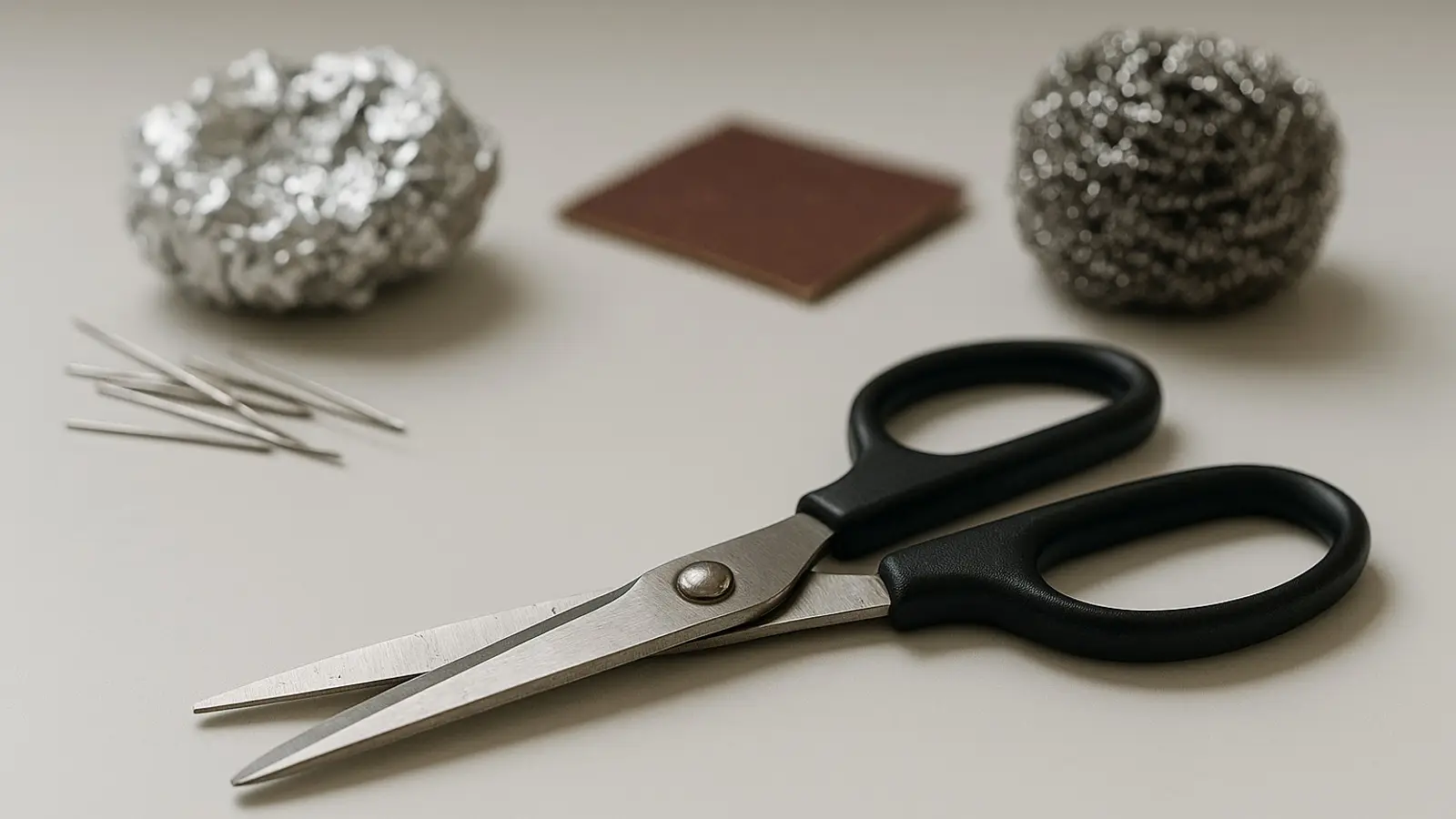https://boda.su/en/posts/id221-sharpen-kitchen-scissors-fast-with-unusual-household-items
Sharpen Kitchen Scissors Fast with Unusual Household Items
How to Sharpen Kitchen Scissors at Home with Everyday Items
Sharpen Kitchen Scissors Fast with Unusual Household Items
Learn how to sharpen dull kitchen scissors at home using a sewing needle, a glass bottle, aluminum foil, sandpaper and steel wool—no special tools needed.
2025-09-05T16:01:54+03:00
2025-09-05T16:01:54+03:00
2025-09-05T16:01:54+03:00
Here’s a simple, no-nonsense way to bring dull kitchen scissors back to life using things you already have at home. There’s no need to buy special tools or a fresh pair—these quick tricks can take a tired edge to razor-like sharpness in about a minute.
Sewing needle
One of the most unusual—and surprisingly effective—helpers is an ordinary sewing needle. Hold a clean needle to the blade, then trap it between the two blades. Open and close the scissors slowly while keeping the needle in place, moving along the cutting edge. Make around six or seven passes, test the edge, and repeat if needed.
Glass bottle
A clean glass bottle from medicine or drinks also does the job. Rinse it well, grip the neck with your scissors, and move the blades back and forth as if you were trying to cut the glass. Work for a few minutes, checking the sharpness as you go.
Aluminum foil
Fold a sheet of foil into two or three layers. Start snipping narrow strips, stopping short of the foil’s edge. Keep cutting until the blades feel sharp enough.
Sandpaper
Use sandpaper the same way you used the foil, but there’s no need to fold it—one sheet is enough. Cut repeated strips until the edge improves.
Metal sponge (steel wool)
Treat a metal sponge just like the foil and sandpaper methods. Have a trash bag ready beforehand so fine fragments don’t scatter over the counter or floor.
Before you start
Clean the blade surfaces from dust and other buildup so nothing interferes with sharpening. Alcohol or other antiseptic solutions work well for this step.
With these quick fixes, cutting stops being a struggle and turns back into an easy, satisfying task. Try the method that’s at hand and get back to work with minimal effort.
Sharpen Scissors, Kitchen Scissors, Home Sharpening, Household Items, Sewing Needle, Glass Bottle, Aluminum Foil, Sandpaper, Steel Wool, No Special Tools, Quick Sharpening Tips
2025
articles
How to Sharpen Kitchen Scissors at Home with Everyday Items
Learn how to sharpen dull kitchen scissors at home using a sewing needle, a glass bottle, aluminum foil, sandpaper and steel wool—no special tools needed.
Generated by Dall-e
Here’s a simple, no-nonsense way to bring dull kitchen scissors back to life using things you already have at home. There’s no need to buy special tools or a fresh pair—these quick tricks can take a tired edge to razor-like sharpness in about a minute.
Sewing needle
One of the most unusual—and surprisingly effective—helpers is an ordinary sewing needle. Hold a clean needle to the blade, then trap it between the two blades. Open and close the scissors slowly while keeping the needle in place, moving along the cutting edge. Make around six or seven passes, test the edge, and repeat if needed.
Glass bottle
A clean glass bottle from medicine or drinks also does the job. Rinse it well, grip the neck with your scissors, and move the blades back and forth as if you were trying to cut the glass. Work for a few minutes, checking the sharpness as you go.
Aluminum foil
Fold a sheet of foil into two or three layers. Start snipping narrow strips, stopping short of the foil’s edge. Keep cutting until the blades feel sharp enough.
Sandpaper
Use sandpaper the same way you used the foil, but there’s no need to fold it—one sheet is enough. Cut repeated strips until the edge improves.
Metal sponge (steel wool)
Treat a metal sponge just like the foil and sandpaper methods. Have a trash bag ready beforehand so fine fragments don’t scatter over the counter or floor.
Before you start
Clean the blade surfaces from dust and other buildup so nothing interferes with sharpening. Alcohol or other antiseptic solutions work well for this step.
With these quick fixes, cutting stops being a struggle and turns back into an easy, satisfying task. Try the method that’s at hand and get back to work with minimal effort.

